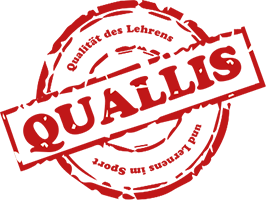In empirical research on teaching quality, a large number of interdisciplinary models have been developed to describe and evaluate teaching quality on the basis of criteria. The question is whether these interdisciplinary models are also valid for the subject of physical activity and sport. Teaching research is increasingly pointing out that teaching quality can only be adequately assessed if subject-specific aspects are included, as these are considered to be particularly eTective for learning. The Quality of Teaching and Learning in Sport (QUALLIS) framework diTerentiates and describes the central characteristics of good Physical Education with reference to current teaching research and sport didactics.
The version 2.0 of the QUALLIS framework concept below was published in autumn 2024 in the journal Sportunterricht in a theoretical article and explained in a practice-oriented teaching aid.
Research on teaching quality has developed various models for describing teaching quality.
The question arises as to whether these interdisciplinary models are also valid for Physical Education, since the learning goals, topics and processes can diTer greatly from subject to subject. This brings sport didactics research into focus, which describes specific teaching and learning processes based on the content of the subject and derives concrete (sub-)dimensions of high-quality Physical Education. In particular, what constitutes successful ‘activation’ is a matter of controversial debate in sport didactics – as in other subjects. Depending on sport didactic concepts and their learning theory foundations, diTerent learning processes are considered important for pupils. Since diTerent learning objects and objectives imply diTerent types of “activation”, learning goal-oriented forms of activation (e.g. cognitive, motor) are to be diTerentiated and located in an overall model of teaching quality in the subject of sport. However, the success of this project will be measured by its widespread implementation in university teaching and teaching practice. This means that the conceptual work must be developed and tested in an iterative process together with teaching practice. Students and teachers should build up important strategies for action (so-called core practices) by acquiring the necessary professional knowledge and by practising the core practices adaptively, flexibly and habitually. In this context, the question arises as to how the (sub)dimensions of quality Physical Education can be made ‘tangible’ for students and teachers. One possibility could be to implement concrete competency-based learning tasks – as a core teaching practice – and to discuss the quality of the implementation along the (sub)dimensions.
This should build up professional knowledge and link it to teaching practice. In a further step, the practical implementation (e.g. in the context of school internships) could be formatively evaluated along the (sub-) dimensions in a criteria-guided manner in order to initiate a process of teaching development. The aim is to develop, implement and evaluate a common understanding of high-quality Physical Education.
Fit with the curriculum
Inclusion of pedagogical perspectives and movement fields
Selection of competences
Determination of meaningful competences and competence levels appropriate to the level of learning.
Linking to learning prerequisites
Consideration and activation of prior knowledge and existing (movement) skills.
Clear learning objectives
Transparent formulation and assessment of diTerentiated learning objectives and application situations.
Appropriate content and methods
Sensible selection and structuring of content and methods, taking into account the learning prerequisites and learning progress (learning levels).
Clarity of rules
Clear formulation, thematisation and enforcement of rules of conduct.
Use of time
Efficient organisation of learning activities and transitions to allow plenty of time for learning and movement.
Omnipresence
Present and approachable teacher who has an overview and control of what is happening in the classroom.
Safety
Ensure physical and mental safety and use materials correctly.
Dealing with disruptions
Dealing with disruptive behaviour and conflicts in an appropriate manner in order to make optimum use of learning time.
Caring and social belonging
Appreciative and equal treatment to promote participation and involvement.
Appreciative feedback and sensitivity
Verbal motivating attention and individual reference norm orientation.
Emotional support
Recognition and support of emotions and effort.
Co-determination and autonomy support
Involving learners and promoting self-determination and co-determination through choice.
Satisfaction and enjoyment
Triggering interest and enthusiasm and arousing positive emotions.
Differentiation and level of challenge
Differentiating, performance-adapted and challenging movement tasks and goals.
Self-regulated learning and practice (design of teaching/learning arrangements)
Exploratory and self-controlled learning and repetitive practice processes.
Structuring and scaffolding
Self-determined and/or externally determined structuring of the practice process and step-by-step support.
Constructive feedback on the task
Learning-accompanying and goal-oriented feedback in verbal and non-verbal dialogue.
Focussing on the effect of movement
External focussing of attention on the effects achieved through movement.
Focussing and understanding movement execution
Understanding the internal directing of attention to body movements and movements.
Creating and reflecting on social interactions
Stimulating collective problem solving and making rules understandable.
Comprehensibility and dialogue
Clarity in verbal and non-verbal explanations and checking understanding through dialogue.
Cognitive processing and self-perception
Explicit reflection on the movement and learning outcome and one’s own (movement) skills.
Support for metacognitive learning
Stimulation of meta-reflection on the subject matter (along the pedagogical perspectives) and control of one’s own learning behaviour.
